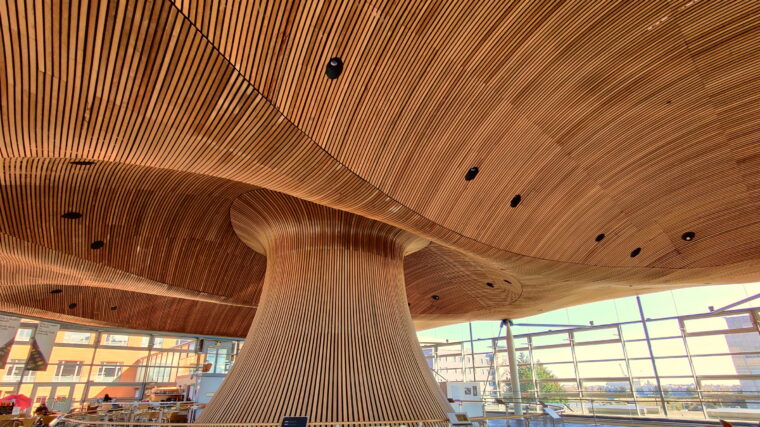Labour’s central economic pledge is to secure the highest sustained growth in the G7 and in turn bring good jobs, productivity growth, and opportunity to every part of the country while delivering on a new industrial strategy and plans for a greener economy.
These ambitions cannot be achieved without sustained investment in research and development (R&D). However, as Labour preaches fiscal prudence in all it does the party has a difficult task to reconcile a small budget envelope with big ambitions for the country.
Starmer
Starmer delivered his new year’s address from the National Composites Centre at the Bristol and Bath Science Park. This was Starmer’s third visit to the Centre which is part of the UK’s Catapult Network and a subsidiary of the University of Bristol.
The thrust of Starmer’s speech was that a vote for the Labour Party is a vote for “national renewal”. This renewal is a break from fourteen years of Conservative government, a commitment to a “lighter politics,” and a promise to prosecute those that have become engorged through the misappropriation of public funds.
Sterner
At first read, the speech contained very little on education or research. There was a mention of technical excellence colleges which would be a rebrand of existing further education colleges funded to specialise in areas adjacent to local skills improvement plans. There was a fleeting reference to introducing “proper” industrial policy. And there was a bit of horizon scanning on the “revolutions in science, energy, technology.”
However, amidst the fog of cautious rhetoric the outlines of an economic policy emerged if you only squint hard enough. It is worth the effort of doing so as Starmer’s economic plans will have significant impacts for research as a whole.
It is worth starting off with the overall spending envelope. In his speech Starmer lamented the simplicity of supposing problems can be fixed with “a big state cheque-book,” he made no mention of what had been a key policy to invest in green-jobs and industry, and while he laboured on reorienting the economy toward working people it is clear there will be little new public spending.
This presents an economic conundrum for Starmer.
He has said economic growth will be Labour’s obsession but limited public spending will make achieving the ambitions in his speech like clean power by 2030, the highest growth in the G7 and the redistribution of wealth away from capital toward workers, challenging.
Smarter?
It is unlikely that a Labour government would reverse the current government’s increased public spending on R&D.
Peter Kyle, Labour’s Shadow Secretary of State for Science, Innovation and Technology, has advocated for longer public research spending settlements. The same funding (inflation adjusted) guaranteed over a longer time period would at least bring some certainty if not immediately expand the size of the UK’s research footprint.
Albeit this footprint has already expanded over the course of this government in part owing to revisions to the way that the ONS calculates R&D spend. It is now estimated the government has already exceeded its target for total R&D spending to reach 2.4 per cent of GDP by 2027. If estimates are correct that spending is closer to 2.9 per cent then this should give latitude for Labour to choose a more stretching R&D target to move the country more toward the likes of Japan and the USA at somewhere between 3.2 and 3.5 per cent of GDP. Labour’s current ambition is at 3 per cent.
A larger R&D spend target would weld Starmer’s aim for economic growth and technological development in areas like the green economy together. However, if the route to growing the UK’s science base is not through an influx of new cash and Starmer is going to, as he said in his speech, “close the book on trickle down nonsense” then his policy proposals are likely to be a mixture of cost neutral(ish) economically redistributive reforms.
For example, Labour’s current thinking about a “proper” industrial strategy is not about a new swathe of state funded industries but about how Labour can set the frameworks, incentives and policies to encourage collaboration between public and private sector enterprises. This means that rather than stepping in only to address market failure Labour will set the rules of how partners will work together on big R&D projects using mechanisms like long-term plans, targeted investment, strategic procurement, target setting, innovation standards and strengthening the supply chain. These are not wholly new ideas but existing, tried, and already piloted ideas, repackaged.
As a starting point Labour will first have to assess the complementarity of the current policy ephemera of various initiatives, moonshots, strategies, and other policies, in achieving a coherent industrial strategy. The UK did of course have an industrial strategy up until 2021 which was abandoned partly owing to an ideological shift in government away from state intervention in the business base.
Again, Labour may be cautious here. In his speech Starmer promised a government which will “tread a little lighter on all of our lives”. Given the frequent R&D policy shifts in the last few years this may be a government of evolution not revolution.
Subtler
Some areas that seem ripe for evolution are implementing elements of the Nurse review particularly on the diversity of the research landscape including the impact of Research Performing Organisations (as an aside, Paul Nurse is a Labour Party member and a patron of Scientists for Labour). Tweaks to spin-out support including national frameworks of expectations on equity, support and agreements. And further nudges to the now consolidated R&D tax credits scheme to encourage investment in sustainable industries and public-private partnerships.
Starmer’s lighter government also includes a recognition that government is “too centralised and controlling.” The current patchwork of devolved R&D policies in particular Freeports and Investment Zones have historically had a mixed economic impact. It is unclear whether they have distributive economic impacts (they may in fact displace existing activity), whether they effectively cluster in the kinds of industries aligned to Labour’s aims like clean energy, and whether the significant tax breaks built into them will contribute to overall economic growth.
If Labour is serious about devolved R&D policy it will have to look at both existing place-based policies and any opportunities to expand devolved R&D funding streams like those received by the Greater Manchester Combined Authority.
Savvier
It is less clear from Starmer’s speech how his party’s ambitions in research align with their ambitions to be both fiscally prudent and redistributive.
A proper green transition will take an enormous amount of funding for new R&D initiatives. More redistributive policies could involve geographic measures like weighting research funding away from the South East. More investment in the development of technical workers coupled with the continuation of more expansive visa regimes for researchers. And potentially new funding arrangements for research organisations to give more latitude for pay and conditions. None of these steps are cost free, technically easy, or entirely politically painless and without risk.
If elected Labour will inherit a R&D policy agenda which has undoubtedly picked up momentum under the Conservative Government. Their challenge is to not only consolidate the progress to date but to coalesce all of the parts of the ecosystem toward their agenda of growing the economy, improving productivity, redistributing wealth, and achieving ambitious goals in sustainability and healthcare.
The last few years have been notable for both the record levels of investment and the significant amount of policy churn. The test for Labour should they win the next election will not only be how much it invests, it will not even be exclusively how it is invested, but how its R&D policies work alongside its broader economic ambitions to bring stability to a research ecosystem which can only thrive where there is certainty about the future.













If we want prosperity and a better way to focus University research, Labour should look at cutting funds for academic research in arts and humanities by at least 70%. The current return on investment is very difficult to calculate and in my opinion very low to negative in terms of return. On the science and technology side, University research needs to be match funded by the private sector £ for £. The current way of allocating research funding is not producing enough return on investment. If it were working, our GDP and productivity would be in the Premier Division, regrettable… Read more »